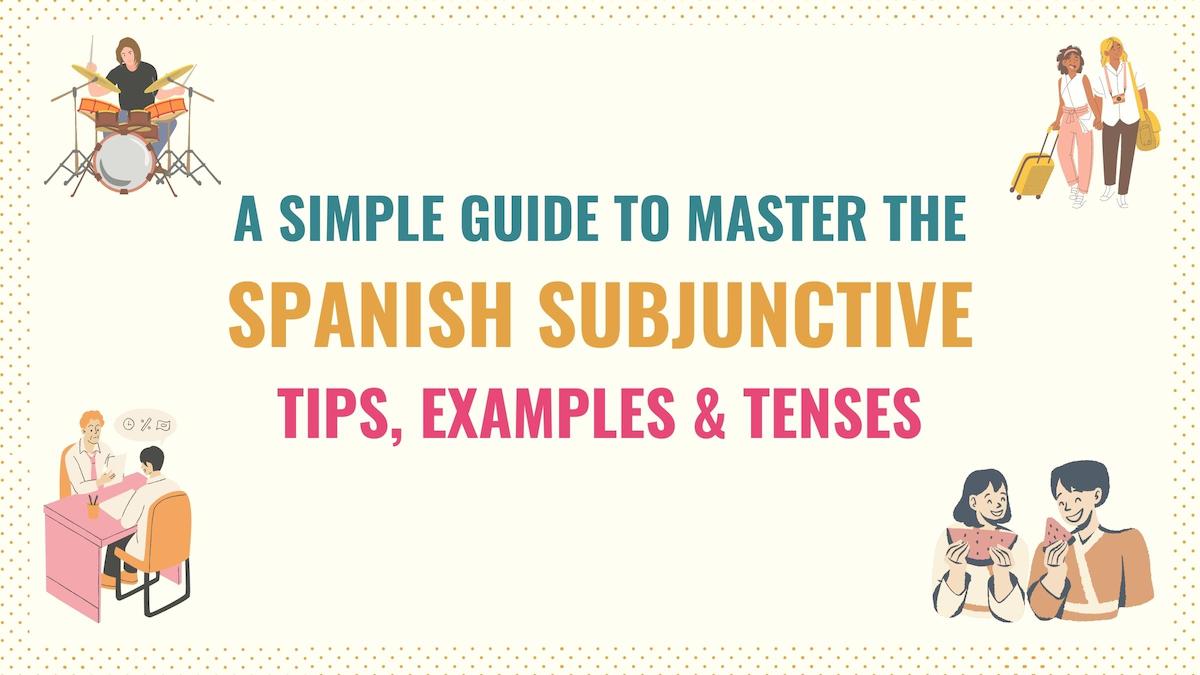The Spanish subjunctive mood is crucial for delivering messages as simple as wishing a person a good day or giving advice. In short, this verb mood is fundamental to understanding and communicating effectively. So, in this subjunctive Spanish guide, you’ll find key information about this mood.
Here is what we’ll cover:
- When to Use the Subjunctive Mood
- When Not to Use the Subjunctive
- Subjunctive Conjugations in Spanish
- Key Points
- Dive Deeper
How & When to Use the Subjunctive in Spanish
The Spanish subjunctive mood refers to subjective and hypothetical situations. In simple words, el subjuntivo allows us to:
- Express hopes and wishes
- Give advice or suggestions
- Describe qualities of unknown people or things
- Request or demand something
- Express feelings and emotions about an event
- Communicate doubts and possibilities
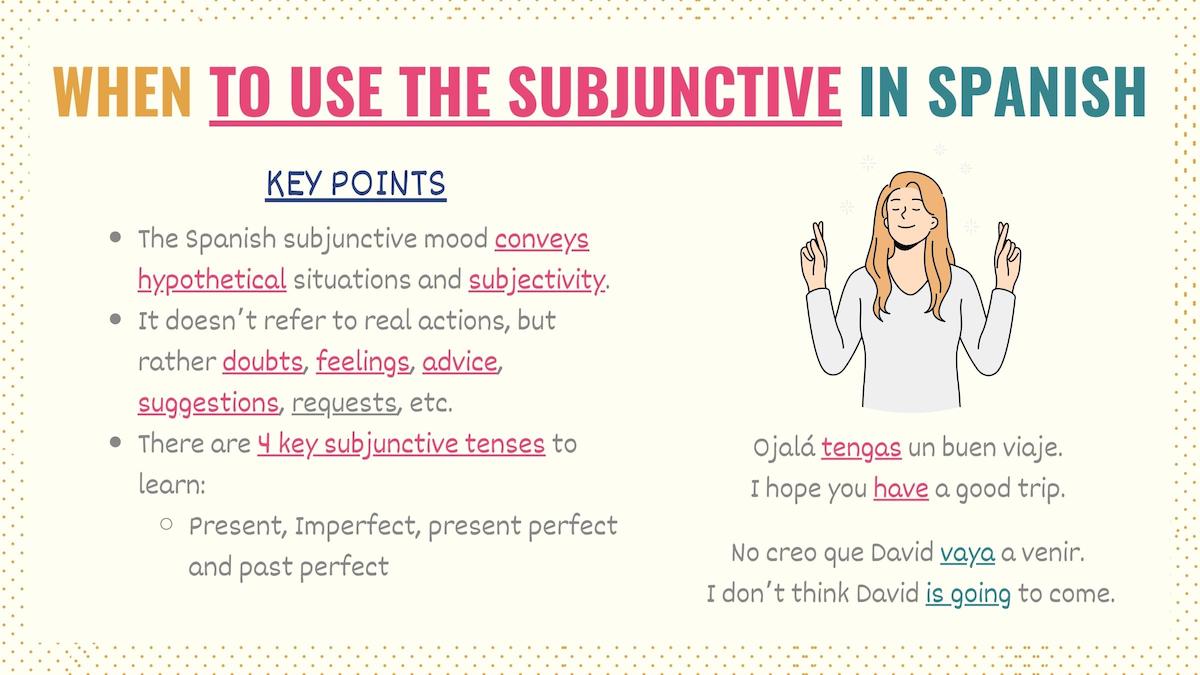
Unlike the indicative mood that focuses on certainty and reality, the subjunctive in Spanish is highly hypothetical. Check these examples:
Ojalá tengas un buen viaje.
I hope you have a good trip.
Les recomendé que vieran esta película.
I recommended them to watch this movie.
Busco una casa que sea grande y accesible.
I’m looking for a house that is big and affordable.
Señora, es necesario que se quede quieta.
Ma’am, you need to stay still.
Me da tristeza que ustedes no se lleven bien.
It makes me sad that you don’t get along.
No creo que David vaya a venir.
I don’t think David is going to come.
Let’s go over some of these sentences. The underlined words are Spanish verbs or phrases in indicative form that express wishes, doubts, feelings, demands, etc. The bolded ones (subjunctive) refer to the action or person towards which we direct this subjectivity.
Take sentence #2 as an example. In this statement, we must use the Spanish subjunctive because, despite my suggestions, we have no way of knowing if my friends are actually going to watch what I said.
This logic applies to all applications except when referring to emotions (sentence #5), which expresses how someone’s action makes you feel.
Take Note: WEIRDO is a popular acronym that provides a simplified explanation of the Spanish subjunctive. However, don’t forget that you must also use this mood to describe characteristics of unknown people or places.
Me gustaría tener un celular que tome buenas fotos.
I would like to have a phone that takes good pictures.
Bethany quiere un novio que sepa cocinar.
Bethany wants a boyfriend that knows how to cook.
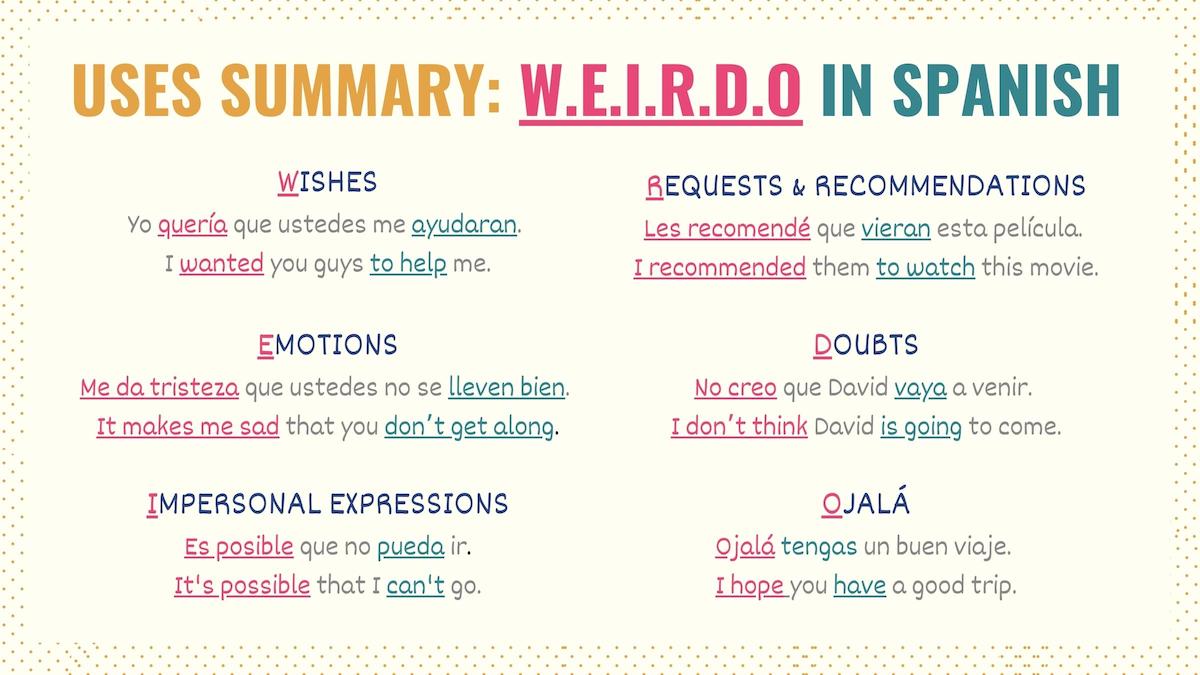
Formula for the subjunctive
In Spanish, sentences that use the subjunctive mood follow a distinctive structure –they have a main and a subordinate clause. In simple terms, subjunctive sentences have two verbs and two subjects.
This structure conveys that a person wishes, feels a certain way, suggests, doubts, or demands that someone else does or has something.
Here is the formula for the Spanish subjunctive:
[Indicative verb] + que + [verb in subjunctive]
Yo quería que ustedes me ayudaran.
I wanted you guys to help me.
Nos alegra que estés bien.
We are happy that you are okay.
¿Quién crees que le haya dicho a Mary?
Who do you think told Mary?
Remember that Spanish subject pronouns can be omitted in a sentence since the conjugation already conveys who the subject is. Also, notice that the verb in subjunctive mood often matches the tense used in the main clause (verb #1).
Simply put, if the first part of the sentence is in present indicative tense, the verb in subjunctive form must also be in present form.
The Spanish subjunctive is also formed with impersonal expressions. These triggers use a similar formula:
[Impersonal expression] + que + [verb in subjunctive]
Es importante que leas las instrucciones.
It’s important that you read the instructions.
Señora, no es necesario que regrese.
Ma’am, you don’t need to come back.
Ojalá is a conjunction or interjection that triggers the subjunctive in Spanish, and it often omits the word ‘que’:
Ojalá puedan venir.
I hope you can come.
Take Note: Reflexive verbs in subjunctive form follow the same conjugation pattern as non-reflexive verbs. However, don’t forget to place the appropriate reflexive pronoun before the conjugated verb – E.g. Espero que te duermas temprano.
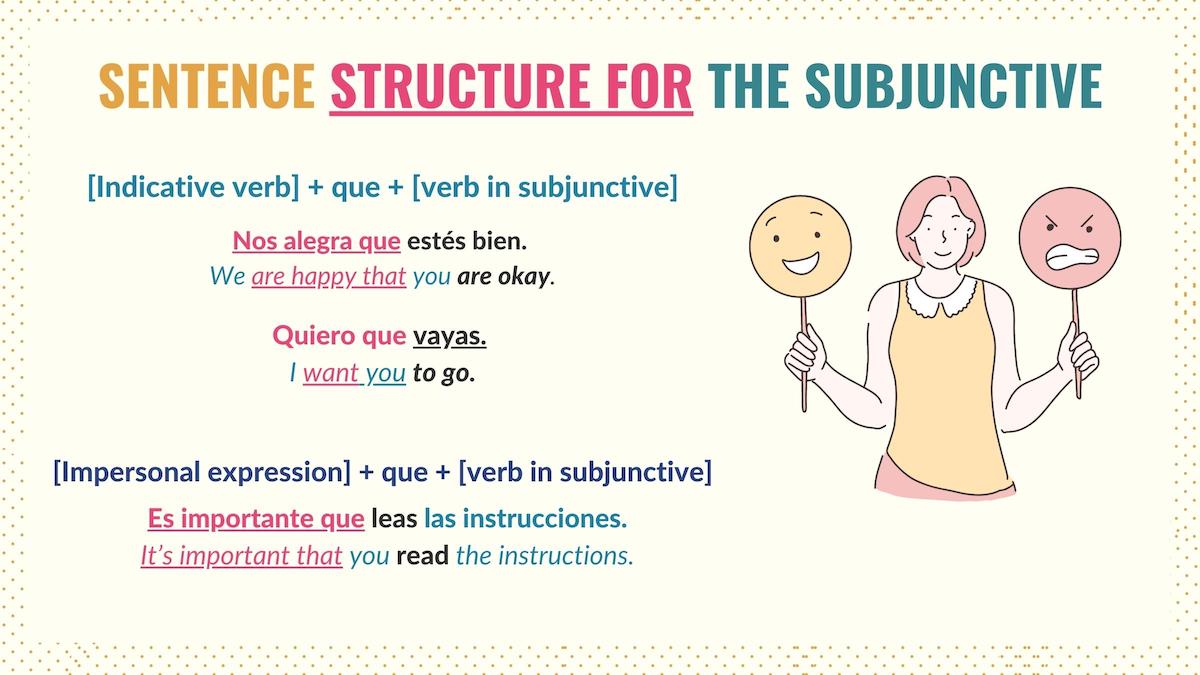
When Not to Use the Subjunctive in Spanish
So, now that you know when to use the subjunctive in Spanish, let’s see when you should not use this mood.
Use the Spanish indicative mood instead of the subjunctive to express certainty or objectivity. In short, to refer to real actions or events that are perceived as factual. Check these sentences:
María no es muy amable.
Maria is not very nice.
Espero que hoy María sea un poco más amable.
I hope that today Maria is nicer.
Notice that the first example is a description based on facts and reality. We describe how Maria is based on our experience. However, the second example (in the present subjunctive) conveys hope about her behavior; like any hope, there’s no certainty that it will happen.
As you know, sentences with the subjunctive are formed with two subjects or an impersonal expression. However, the subjunctive is not used if those hopes, demands, advice, or doubts are directed toward the same subject. In such cases, you must use an infinitive verb.
[Verb conjugated] + [infinitive]
Espero llegar temprano.
I hope I arrive early.
Ustedes necesitan descansar más.
You guys need to rest more.
Sandra quería viajar con su familia.
Sandra wanted to travel with her family.
Take Note: The subjunctive is one of the three Spanish verb moods. Although they’re often confused, the indicative and subjunctive express different meanings. So, you should take the time to understand when to use subjunctive or indicative in Spanish.
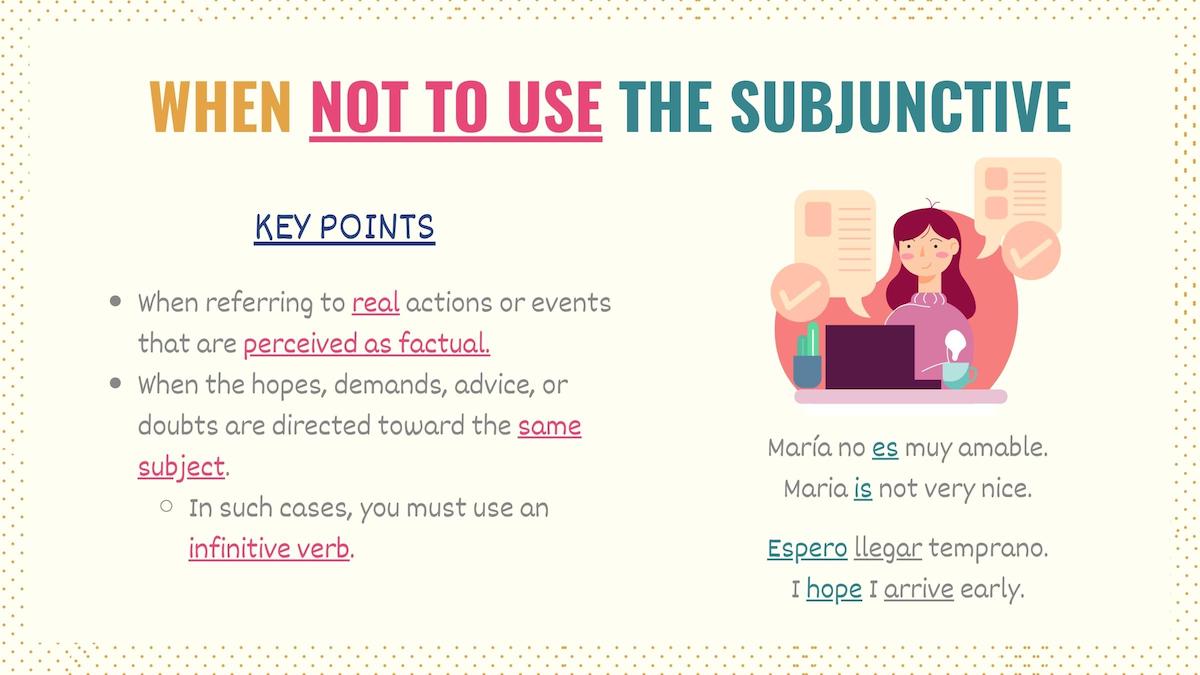
Spanish Subjunctive Tenses & Conjugations
There are four main subjunctive Spanish tenses used in the modern-day Spanish language:
Simple subjunctive tenses:
- Present subjunctive
- Imperfect or past subjunctive
Compound subjunctive tenses:
- Present perfect subjunctive
- Past perfect subjunctive
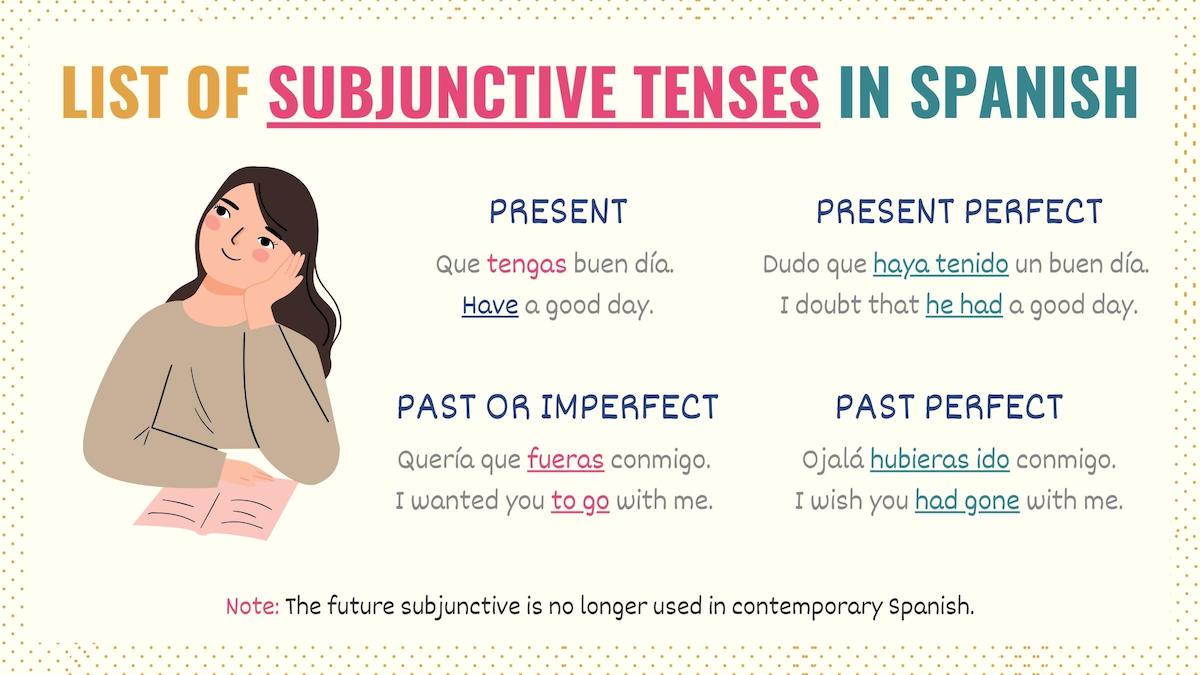
Let’s check the endings that you’ll use for each tense.
Take Note: The subjunctive mood also has future and future perfect tenses. However, these tenses have fallen out of use and, as a result, you shouldn’t worry about learning them.
Present subjunctive
The Spanish present subjunctive is used to express current wishes, demands, emotions, and doubts and describes unknown people or things in the present. The regular endings to form this tense are:
| Person | AR | ER / IR |
|---|---|---|
| Yo | -e | -a |
| Tú | -es | -as |
| Él / Ella Usted | -e | -a |
| Nosotros | -emos | -amos |
| Vosotros | -éis | -áis |
| Ellos / Ellas Ustedes | -en | -an |
Ojalá que Juan compre más galletas.
I hope Juan buys more cookies.
Ven a verme cuando termines.
Come to see me when you finish.
Check the rules to conjugate the Spanish present subjunctive since these forms are heavily based in the present indicative.
Imperfect subjunctive
On top of expressing past hopes, skepticism, and suggestions, the imperfect subjunctive in Spanish is also used to express politeness. The past subjunctive endings for regular and irregular verbs are:
| Person | Past subjunctive endings |
|---|---|
| Yo | -ra /-se |
| Tú | -ras /-ses |
| Él / Ella Usted | -ra /-se |
| Nosotros | -ramos /-semos |
| Vosotros | -rais /-seis |
| Ellos / Ellas Ustedes | – ran /-sen |
Esperaba que tuvieras tiempo de ayudarme.
I was hoping that you had time to help me.
Mis amigos querían que fuésemos a correr.
My friends wanted us to go running.
As you can probably tell, the past perfect subjunctive conjugation leverages the past preterite tense forms.
Take Note: The past imperfect subjunctive tense has two different endings (conjugation models) depending on whether you’re using Latin American or Castilian Spanish. Check out the guide on this tense to learn more.
Compound tenses
The compound forms of the Spanish subjunctive are formed with the same elements – the auxiliary verb haber and a past participle.
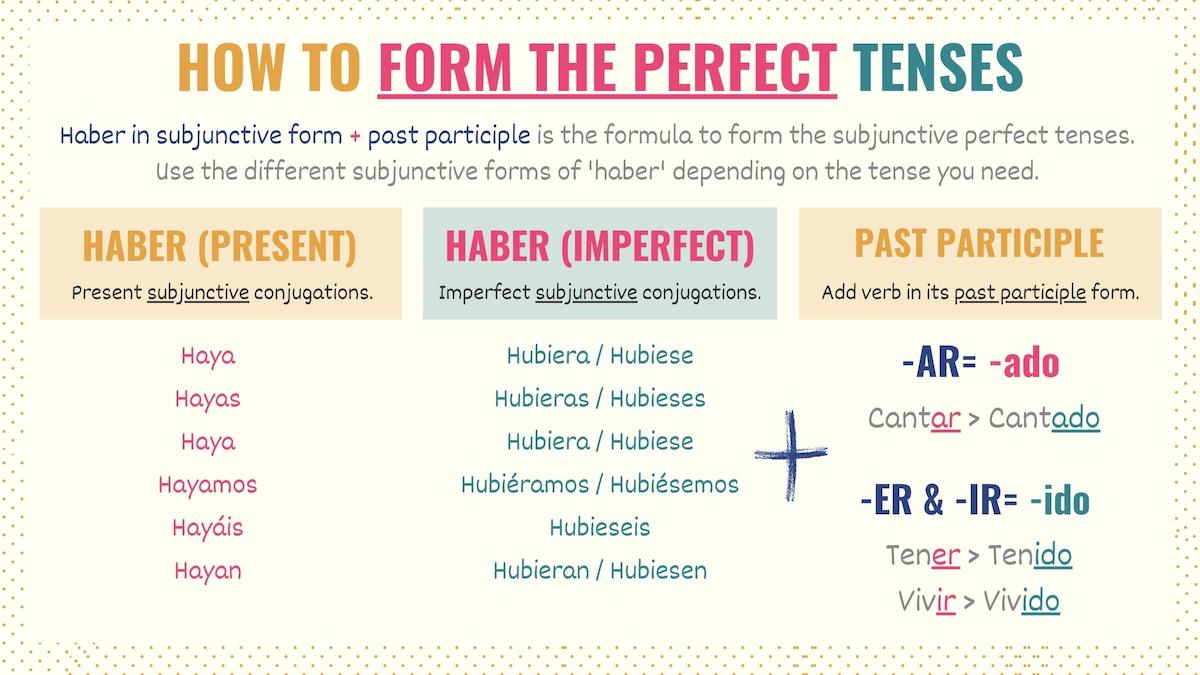
Although they’re formed with the same elements, these forms have different purposes.
The Spanish present perfect subjunctive conveys current emotions, wishes, or uncertainty about a past action relevant to the present. For instance:
No creo que Luis se haya enojado contigo.
I don’t think Luis got upset with you.
Dudo que los niños hayan limpiado su cuarto.
I doubt that the kids have cleaned their room.
On the other hand, the past perfect subjunctive in Spanish allows you to express regrets and hypotheses about things that could have happened:
Ojalá me hubieras dicho antes.
I wish you had told me sooner.
Si hubieras ido, te habrías divertido.
If you had gone, you would have had fun.
Key Points: Subjunctive Rules
The subjunctive mood is crucial for communicating clearly and effectively in Spanish. Here are some important rules and main ideas to remember:
- The Spanish subjunctive conveys the speaker’s subjectivity.
- As a result, it’s used to express uncertainty, hopes, feelings about an action or behavior, requests, and suggestions, and describe the qualities of an unknown person or place.
- The actions expressed with the subjunctive are hypothetical because they have not occurred, and we do not know if they will happen.
- Sentences with the subjunctive use two subjects and two verbs.
- Subjunctive statements express that someone wishes, suggests, or has a certain emotion or doubts about another person’s actions, behaviors, or states.
- We must use an infinitive verb when the hopes, needs, or recommendations are directed toward the same subject.
- The subjunctive mood in Spanish has four main tenses: present, past, present perfect, and past perfect.
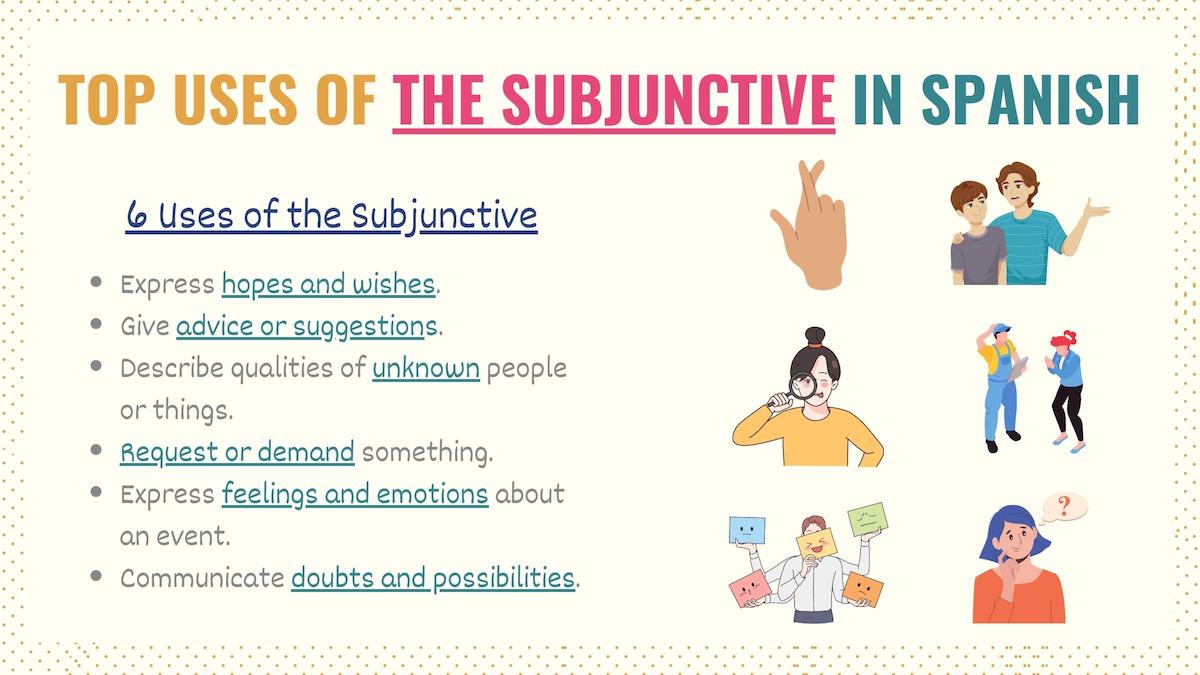
Subjunctive Spanish Additional Resources
For many Spanish learners, the subjunctive mood can be challenging. To master it, you should first know what Spanish verb moods are and how they work. Understanding the differences between indicative and subjunctive can help you familiarize yourself with the applications of this mood.
Also, identifying phrases and verbs that trigger the subjunctive will allow you to quickly know when to use the subjunctive. Finally, I encourage you to check our conjugation hub page so that you can practice the conjugation endings for the subjunctive forms.
Download the Spanish Subjunctive Mood PDF
The Spanish subjunctive mood is by far the most difficult mood and set of tenses for most learners to understand and use in their daily conversations. I’ve created a PDF for this guide you can download for free to review whenever you need. It has all the graphics, key points, and rules for how and when to use the subjunctive in Spanish

